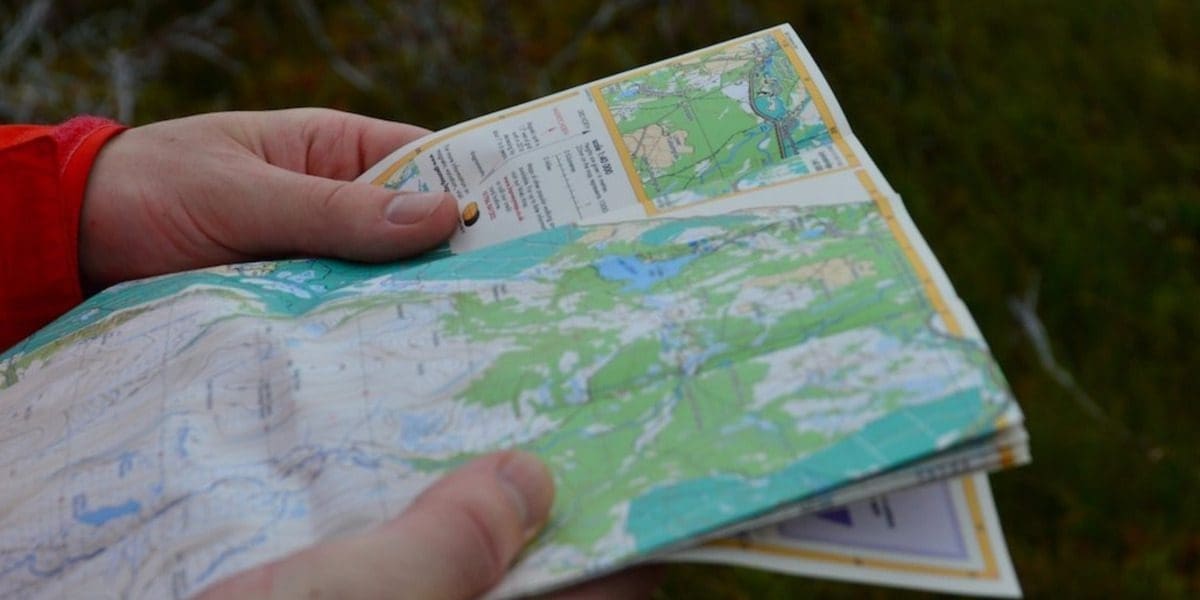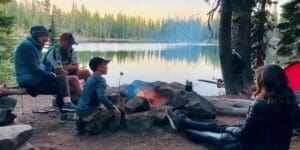Heading out for your first family hiking trip? Before you embark, make sure to understand the basics of what’s needed! Research different trails in your area suited for everyone’s skill level – this will ensure a great experience.
Hiking is an awesome way to bond with loved ones and explore nature; it can be such an incredible excursion that works well no matter how old or young each member may be. If you’ve got young kids or hikers who are new to the game, it’s a good idea to search for trails with moderate distances and terrain that isn’t too hard. It might be worth looking into what kind of scenery each one has on offer as well – some may have more magnificent views than others!
Doing your research can help make sure everyone is prepared so there won’t be any nasty surprises when out on the trail. Plus, don’t forget to equip all involved with essential items before getting going; this will come in handy and should ensure smooth sailing throughout!
Before heading out on an outdoor adventure with your kids, make sure you’re prepared by packing the proper supplies. That means having good shoes that stay put, getting some rain gear if needed (it never hurts to be prepared!), and plenty of water and snacks for energy boosts throughout the hike. Sunscreen or bug spray is a must during different seasons; don’t forget about hats and gloves depending on weather conditions as well!
Family Hiking Checklist – Basic Gear Ideas
When it comes to embarking on a family hiking adventure, it’s important to be prepared and equipped with the right gear. Whether you’re planning a leisurely stroll through the woods or tackling a challenging trail, having the proper equipment will ensure a safe and enjoyable experience for everyone. Here’s a handy checklist of basic gear that you should at least consider before hitting the trail:
Clothing & Footwear
- Comfortable and moisture-wicking hiking boots or trail shoes
- Breathable and quick-drying hiking socks
- Lightweight and moisture-wicking base layers
- Sturdy and flexible hiking pants or shorts
- Layered clothing options for varying weather conditions
- Waterproof and wind-resistant jacket or shell
- A wide-brimmed hat to protect against the sun
- Gloves and a scarf for colder temperatures
Backpack Essentials
- Spacious and durable backpack with multiple compartments
- Hydration system or water bottles to stay refreshed on the trail
- Nutritious snacks and energy bars to keep your energy levels up
- Small first aid kit with basic supplies like bandages and antiseptic wipes
- Compass or GPS device for navigation assistance
- Whistle for emergencies and to attract attention, if needed
- Pocket knife or multi-tool for various tasks
- Lightweight rain poncho or waterproof cover for your backpack
- Sunscreen lotion to protect your skin against harmful UV rays
- Insect repellent to ward off pesky bugs
Safety Equipment
- Flashlight or headlamp with extra batteries for nighttime exploration
- Lightweight and compact emergency blanket
- Lightweight and sturdy trekking poles for stability on uneven terrain
- Reflective gear or clothing for better visibility in low-light conditions
- Portable and fully-charged cellphone for emergencies
Miscellaneous Items
- A lightweight and compact camera to capture memorable moments
- Binoculars for observing wildlife and scenic views
- Trail maps and guidebooks for navigation and exploration
- Environmentally friendly reusable water bottle
- Plastic bags for trash and storing wet or dirty items
- Portable camping stove and cookware for outdoor cooking adventures
- Extra cash for parking fees, trail permits, or unexpected needs
Remember, the key to a successful family hike is not only the gear but also the spirit of adventure and togetherness. So, pack up your gear, hit the trails, and create lasting memories with your loved ones.
You’ll also need either direction from someone who knows their way around or, better yet – pick up a map – plus flashlights/headlamps in case you end up doing any night hiking (which is not recommended when it comes to smaller children).

Discover the hidden gems along the trail route! Before embarking on your adventure, it’s important to familiarize yourself with the local camping regulations. Don’t forget to check if you need any permits to spend the night at your chosen spot. Your safety and enjoyment matter to us, so make sure you have all the information you need before setting up camp.
All these things will ensure everyone has fun safely, no matter what kind of outdoorsy stuff they get into – especially those little adventurers among us!
So, if you’re heading out for your first family hiking trip… Before you go, make sure to research trails suitable for all skill levels. Hiking is a great way to bond and explore nature, regardless of age. For beginners or young kids, choose trails with moderate distances and easy terrain. Consider the scenery too, as some trails offer more breathtaking views. Do your research to ensure everyone is prepared and avoid any surprises. Don’t forget essential items like sturdy shoes, rain gear, water, snacks, sunscreen, bug spray, hats, gloves, flashlights/headlamps, and first aid supplies. Check local regulations and permits if camping overnight. These tips will help you have a safe and enjoyable outdoor adventure with your little adventurers.
FAQs
Q: What are the benefits of family hiking?
A: Family hiking offers a multitude of benefits that go beyond just physical exercise. It provides an opportunity for quality family bonding time, allowing you to create everlasting memories while exploring the great outdoors together. This activity promotes a healthy lifestyle by improving cardiovascular fitness and boosting mental well-being. Family hiking also enhances children’s cognitive development and instills in them a sense of curiosity and wonder about the natural world. By immersing themselves in nature, children develop a deeper appreciation for the environment and learn valuable lessons about conservation. Additionally, hiking stimulates creativity and problem-solving skills as they navigate through various terrains and overcome obstacles. So, lace up your boots, pack your backpacks, and embark on a family hiking adventure to reap these incredible benefits.
Q: How can I ensure the safety of my family while hiking?
A: Safety should always be a top priority when embarking on a family hiking expedition. Start by choosing appropriate trails that match your family’s fitness levels and hiking experience. Check weather forecasts and trail conditions before heading out to avoid any unexpected hazards. It’s crucial to pack essential safety gear such as a first aid kit, extra clothing layers, sufficient water, and high-energy snacks. Educate your family members about trail etiquette and wildlife encounters, emphasizing the importance of respecting nature and leaving no trace. Stay hydrated, take frequent rests, and pace yourself to avoid fatigue or injuries. Teach your children about potential dangers they might encounter on the trail, such as poisonous plants or steep drops. By prioritizing safety and preparedness, you can ensure a memorable and incident-free hiking experience for the whole family.
Q: How do I choose family-friendly hiking trails?
A: When selecting family-friendly hiking trails, consider the following factors: distance, difficulty level, and amenities available. Look for trails that offer shorter distances suitable for children’s abilities and attention spans. Opt for well-marked and maintained paths to avoid confusion or getting lost. Trails with amenities like restrooms, picnic areas, and playgrounds can enhance the overall experience for families. Research online or consult with local park rangers to find trails with scenic views or interesting points of interest that will captivate everyone’s attention. It’s also essential to consider the terrain and elevation gain to ensure it aligns with your family’s fitness levels and abilities. By choosing family-friendly trails, you can create a positive and enjoyable hiking experience for everyone involved.
Q: What equipment should I bring for family hiking?
A: Packing the right equipment is crucial for a successful family hiking adventure. Start with appropriate footwear, such as sturdy hiking boots or shoes that provide good traction and ankle support. Dress in layers, considering the weather conditions, and bring rain jackets or windbreakers for unexpected changes in climate. Essential gear includes a backpack with enough capacity to carry water, snacks, extra clothing, a first aid kit, a map and compass or GPS device, a whistle, a flashlight, and a multi-tool. Depending on the duration of the hike and accessibility to water sources, you may need a water filtration system or water bottles. Don’t forget sunscreen, hats, and sunglasses to protect against sun exposure. By having the right equipment, you can ensure comfort, safety, and preparedness during your family hiking trips.
Q: How can I make hiking enjoyable for young children?
A: To make hiking enjoyable for young children, it’s essential to incorporate fun and engaging activities along the way. Plan shorter hikes with frequent breaks so they can rest, explore, and play. Encourage them to observe and identify plants, animals, or interesting natural features they come across using field guides. Create a scavenger hunt by making a list of things for them to find, such as specific types of leaves, rocks, or animal tracks. Pack snacks that they can look forward to and enjoy during breaks. Consider bringing small toys or items that spark their imagination, such as binoculars or a magnifying glass. Be patient and take the time to explain the wonders of nature they encounter, fostering their curiosity and love for the outdoors. By making hiking a fun and interactive experience, you can create cherished memories for your young adventurers.
Q: What is trail etiquette and why is it important?
A: Trail etiquette refers to the set of guidelines and behaviors that hikers should follow to ensure a respectful and harmonious hiking experience for everyone. It involves being considerate towards fellow hikers, nature, and wildlife. Stay on designated trails to avoid damaging vegetation or disturbing habitats. Yield to uphill hikers and let faster hikers pass when the trail narrows. Keep noise to a minimum to preserve the tranquility of the surroundings. When encountering wildlife, maintain a safe distance and observe without disturbing their natural behavior. Follow the principle of “Leave No Trace” by properly disposing of waste, picking up litter, and not damaging or removing natural objects. By practicing trail etiquette, you contribute to the preservation of the environment and help create a positive hiking atmosphere for all.
Q: How can I involve my kids in the planning process of a family hiking trip?
A: Involving your kids in the planning process of a family hiking trip not only makes them feel part of the adventure but also helps teach them valuable skills. Start by discussing the destination and asking for their input on what they would like to see or experience. Let them assist in selecting the trail and researching interesting facts or stories about the area. Allow them to help pack their backpacks, ensuring they have their own water, snacks, and any special items they wish to bring. Encourage them to navigate using a map or GPS device, developing their spatial awareness skills. By involving your kids in the planning process, you foster their sense of responsibility, curiosity, and independence, enhancing their overall hiking experience and instilling a love for outdoor exploration.
Q: How can I keep my kids engaged during long hikes?
A: Long hikes can sometimes be challenging for children, but there are several strategies to keep them engaged and interested. Break the hike into smaller, manageable sections, setting achievable goals along the way. Plan interesting stops, such as waterfalls, viewpoints, or natural landmarks, as rewards for reaching certain milestones. Encourage interactive activities, such as storytelling, singing songs, or playing nature-themed games. Point out interesting flora and fauna, explaining their characteristics and significance. Consider bringing a camera or letting them take pictures with a phone or tablet to document their journey and capture moments of excitement. Snack breaks can also serve as essential motivators and opportunities to refuel. By incorporating these engaging techniques, you can make long hikes enjoyable and memorable for your kids.
Q: What should I do if someone gets injured on a family hiking trip?
A: If someone gets injured during a family hiking trip, it’s essential to remain calm and take immediate action. Assess the severity of the injury and provide first aid as necessary. This may include cleaning and bandaging wounds, applying ice packs to reduce swelling, or immobilizing sprained limbs. If the injury is severe, such as a broken bone or head trauma, call for emergency assistance or seek help from nearby hikers. It’s crucial to carry a fully stocked first aid kit and know how to use it effectively. If the injured person can still move, consider assisting them back to the trailhead or a safe location where they can receive medical attention. Prevention is key, so always hike within your family’s abilities and be cautious of potential hazards. Remember, safety is paramount, and seeking professional medical help when needed is crucial in ensuring a positive outcome.
Q: How can I make camping with family more enjoyable?
A: Camping with family can be an exciting and rewarding experience. To enhance the enjoyment, consider the following tips. Plan ahead by researching and booking campsites that offer family-friendly amenities such as restrooms, picnic areas, and fire pits. Involve your kids in setting up the campsite, allowing them to help pitch tents or gather firewood. Plan fun activities such as stargazing, storytelling around the campfire, or cooking meals together. Bring camping games or outdoor toys to keep everyone entertained during downtime. Encourage exploration of the surrounding area, pointing out the beauty of nature and teaching them about the importance of conservation. Remember to pack essential camping gear, including a comfortable sleeping bag, camping stove, cooking utensils, and insect repellent. By incorporating these elements, you can create lasting memories and foster a love for outdoor adventures among your family members.
Q: How can I introduce my family to outdoor activities and nature exploration?
A: Introducing your family to outdoor activities and nature exploration is a wonderful way to connect with nature and each other. Start by planning short hikes or nature walks in nearby parks or nature reserves. Encourage your family members to observe and discuss the natural surroundings, pointing out interesting plants, animals, or geological formations. Plan visits to zoos, botanical gardens, or wildlife sanctuaries to experience nature firsthand. Consider organizing weekend camping trips or family outdoor outings to immerse yourselves in the beauty of the wilderness. Get involved in community programs or join local environmental organizations that offer nature education activities for families. By gradually exposing your family to outdoor activities and nature exploration, you can ignite their curiosity and foster a love for the natural world.





















